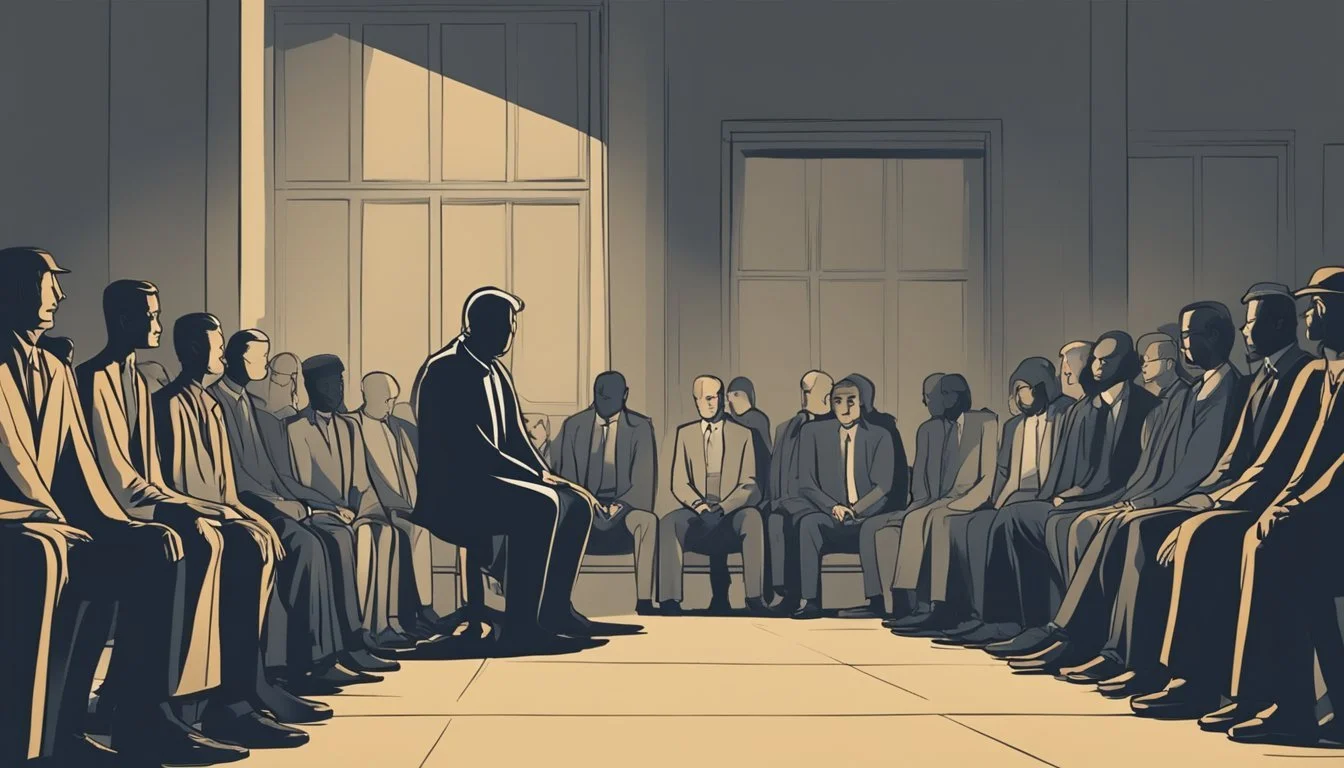10 Strategies for Coping with PTSD-Related Survivor's Guilt
Expert Tips for Healing
Survivor's guilt is a psychological condition that often accompanies Post-Traumatic Stress Disorder (PTSD), especially in those who have experienced life-threatening events. Survivors may wrestle with feelings of unearned fortune and question why they survived when others did not. This can lead to deep emotional pain and distress, complicating the healing process.
The strategies to cope with PTSD-related survivor's guilt can offer valuable tools to manage these overwhelming emotions effectively. Understanding and addressing these feelings is crucial to moving towards a balanced and healthy mental state. The following outlines effective methods to help survivors navigate their emotional landscape and find a pathway to resilience.
1) Cognitive Behavioral Therapy
Cognitive Behavioral Therapy (CBT) is an effective approach for managing PTSD-related survivor's guilt. It focuses on the interplay between thoughts, emotions, and behaviors. By identifying and challenging unhelpful thought patterns, individuals can experience significant emotional and behavioral improvements.
CBT helps individuals reframe negative self-perceptions and reduce feelings of guilt associated with traumatic events. This addresses the root causes of distress and enhances overall emotional regulation.
CBT sessions typically involve structured interventions over several weeks. This allows for gradual but consistent progress. Techniques like cognitive restructuring and exposure therapy are common tools used during these sessions.
Practical exercises and worksheets may also be used to support the therapy process, providing individuals with tangible ways to practice new skills.
Given its structured and evidence-based approach, CBT is a valuable option for those struggling with the complex emotions tied to survivor's guilt. More details about how CBT works for PTSD can be found in this article.
Moreover, organizations like APA highlight how altering unhelpful thinking patterns can lead to healthier behaviors and improved functioning.
2) Mindfulness Meditation
Mindfulness meditation involves focusing on the present moment while acknowledging and accepting one's feelings, thoughts, and bodily sensations without judgment.
Practicing mindfulness can help individuals with PTSD-related survivor's guilt by reducing stress and emotional reactivity. Regular sessions can improve emotional regulation and foster a sense of calm.
Studies have shown that mindfulness-based interventions can decrease PTSD symptoms. For instance, a 12-week loving-kindness meditation intervention for veterans noted reductions in PTSD and depressive symptoms.
Yoga, as a mindfulness practice, combines breathing, stretches, and mindfulness to cultivate peace. It has been demonstrated to reduce physical and emotional stress, aiding those with PTSD in managing their symptoms.
A 2021 study found that an 8-week mindfulness-based, trauma-informed program promoted resilience among women veterans with PTSD and chronic pain.
Incorporating mindfulness into daily routines can lead to lasting benefits. Individuals might consider guided meditation apps, local classes, or online resources to begin their mindfulness journey.
Mindfulness meditation is a potent tool for anyone struggling with survivor's guilt related to PTSD. Through consistent practice, individuals can gain greater self-awareness and emotional balance.
3) Support Groups
Support groups provide a powerful way to cope with PTSD-related survivor's guilt. They offer a safe space for individuals to share their experiences and feelings with others who understand what they're going through. Connecting with people facing similar challenges can reduce feelings of isolation.
Participating in a support group can also provide practical advice and coping strategies. Group members often share techniques that have helped them manage their own PTSD symptoms and survivor's guilt. This exchange of ideas can be incredibly beneficial.
Many online support groups are available for those who cannot attend in person. Platforms like After Silence offer support specifically for survivors of rape, sexual abuse, and sexual assault.
There are also specialized communities, such as the CPTSD Community Safe Group, for those dealing with complex PTSD. These online resources provide flexibility and accessibility, crucial for individuals with varying schedules and comfort levels.
Involvement in a support group can also lead to lasting friendships and a sense of community, which are important for ongoing recovery. Building these relationships can help individuals feel more grounded and supported in their healing journey.
4) 'Healing doesn’t mean the damage never existed. It means the damage no longer controls our lives.' - Akshay Dubey
Healing from PTSD-related survivor's guilt involves recognizing that past experiences and traumas do not dictate future wellbeing.
Akshay Dubey’s quote sheds light on the reality that while the pain and damage from past events stay with us, their impact on daily life diminishes as healing occurs.
This distinction between healing and erasure is crucial. Healing involves acknowledging the hurt while striving to move beyond its grasp.
Those suffering from PTSD-related survivor's guilt can reflect on this idea as they work through their trauma. Embracing this mindset can foster resilience.
Survivors often struggle with feelings of remorse and anxiety. Understanding that healing doesn’t mean forgetting can ease some of this burden.
As they progress, control over their emotions and reactions improves. The past becomes a chapter, not the entirety of their story. This perspective change can be liberating.
For anyone grappling with PTSD, it is essential to know healing is about reducing the power of past traumas. Akshay Dubey's words encapsulate this profound truth, offering hope and encouragement.
5) Exercise Routines
Physical exercise can play a crucial role in helping those with PTSD-related survivor's guilt. Regular activity can alleviate symptoms by promoting overall physical and mental well-being. Activities such as running, swimming, and cycling engage the body, releasing endorphins that improve mood and reduce stress.
Yoga is particularly beneficial for individuals coping with PTSD. It helps them focus on the present moment and reduces rumination. Studies have shown that yoga can combat negative thinking patterns, making it a valuable tool for managing survivor's guilt Psychology Today.
Group exercise classes, like aerobics or dance, can provide a sense of community and support. Participating in these activities with others can foster a sense of belonging, which helps mitigate feelings of isolation often associated with survivor's guilt.
Strength training is another effective exercise routine. It not only builds physical strength but also enhances mental resilience. Engaging in weightlifting or resistance exercises can boost self-esteem and confidence, essential for overcoming guilt.
Finally, incorporating mindful walks in nature can be therapeutic. Walking in natural settings allows for mindfulness practice, which can calm the mind and provide perspective, aiding in the emotional healing process.
6) Art Therapy
Art therapy offers individuals a creative way to process intense emotions linked to PTSD-related survivor's guilt. Engaging in activities such as drawing, painting, and sculpture can provide an expressive outlet for feelings that may be difficult to verbalize.
The act of creating art can help individuals access their subconscious mind. This can be especially useful for those struggling with internalized trauma. By focusing on artistic expression, people may find it easier to confront and understand their emotions.
Art therapy also promotes relaxation and stress relief. Activities like painting or drawing can shift focus away from distressing thoughts. This helps individuals to find a sense of calm and balance.
For individuals with PTSD, art therapy can be a non-verbal way to communicate their experiences. This makes it a valuable tool for those who find traditional talk therapies challenging.
For more insights into the benefits of art therapy, resources such as Psych Central and Healthline offer detailed information. These resources emphasize how art can open up new avenues for healing trauma.
7) Trauma-Focused Therapy
Trauma-focused therapy is a specialized approach designed to help individuals process and overcome the emotional and psychological effects of trauma. This therapy acknowledges the pervasive impact of trauma on a person's life.
One important aspect is the emphasis on physical, psychological, and emotional safety. Creating a safe environment allows survivors to explore their experiences without fear.
Another key element involves helping clients regain a sense of control and empowerment. This fosters resilience and aids in the recovery process.
Trauma-focused therapy incorporates various techniques to address trauma. Cognitive processing therapy (CPT) aims to help individuals reframe and process traumatic memories. It is particularly effective for those feeling "stuck" in their negative thoughts about the trauma.
Psychoeducation is also a crucial component. It helps survivors understand their responses to trauma, validating their experiences as normal reactions to abnormal situations.
This form of therapy may also include solution-focused techniques. These emphasize finding exceptions to the problem and leveraging existing strengths to foster change.
The goal is to facilitate healing and post-traumatic growth, empowering individuals to lead fulfilling lives despite their past experiences.
8) Journaling Practices
Journaling can be a powerful tool for coping with PTSD-related survivor's guilt. Writing down thoughts and emotions helps individuals process their experiences. It provides an outlet for expressing feelings that might be difficult to voice.
Structured approaches to journaling are often effective. Techniques like journal prompts, sentence stems, and list-making can give direction to the writing process. These methods help individuals explore their emotions in a controlled and constructive manner.
When dealing with trauma, it's essential to create a safe space in the journal. This means allowing oneself to write freely without fear of judgment. Over time, this practice can lead to greater self-awareness and emotional healing.
Expressive writing can also physically benefit the writer by reducing tension and restoring focus. Regular journaling can decrease stress levels, making daily life more manageable.
For those new to journaling, starting with a few minutes a day can be helpful. Gradually increasing the time spent writing can make the practice more sustainable. It's also important to revisit previous entries to observe progress and changes in emotional states.
Incorporating these journaling practices can support the overall trauma recovery journey. These techniques can be adapted to individual needs, providing flexibility and personal relevance.
9) Seeking Professional Help
Professional help is a critical resource for those struggling with PTSD-related survivor's guilt. Therapists and counselors specializing in trauma can offer valuable insights and coping mechanisms tailored to individual needs.
Cognitive Behavioral Therapy (CBT) is a widely recognized approach. It helps individuals reframe negative thought patterns and reduce guilt by addressing the root causes.
Eye Movement Desensitization and Reprocessing (EMDR) offers another therapeutic option. This technique involves guided eye movements to process and integrate traumatic memories more effectively.
Group therapy provides additional support. Sharing experiences with others who have faced similar challenges can foster a sense of community and reduce feelings of isolation.
Online therapy platforms make professional help more accessible. These services offer convenience and confidentiality, ensuring that individuals can receive support from the comfort of their own homes.
Consulting a psychiatrist may be necessary if medication is required. Antidepressants or anti-anxiety medications can alleviate symptoms and support recovery when used alongside therapy.
It's essential to find a therapist who is a good fit. Building a trusting relationship with a mental health professional enhances the therapy's effectiveness.
10) Education about PTSD
Knowledge about PTSD can be a powerful tool for managing survivor's guilt.
Educating oneself about PTSD helps individuals understand the causes and symptoms of this condition. This awareness reduces confusion and frustration, making it easier to cope.
Psychoeducation involves learning about PTSD and how various factors impact it. Individuals gain clarity on why they might experience particular emotions and reactions.
Understanding triggers can also be crucial. Knowing what events or situations might aggravate symptoms allows for better planning and avoidance strategies.
Many resources are available for those seeking to learn more. Websites like Mind Diagnostics offer articles and tools for managing PTSD.
Support groups provide firsthand exposure to others’ experiences and insights. This collective knowledge contributes significantly to one's understanding of their own condition.
Educational resources, such as the National Center for PTSD, offer self-assessments and symptom-tracking tools that aid in monitoring one’s progress.
Moreover, online courses and workshops can deepen this knowledge, offering practical strategies to cope with PTSD symptoms. It is beneficial to stay informed through credible sources like Healthline.
Armed with this education, individuals are better equipped to face PTSD symptoms and develop effective coping mechanisms.
Understanding PTSD and Survivor's Guilt
Post-traumatic stress disorder (PTSD) and survivor's guilt often coexist, especially after experiencing or witnessing traumatic events. Survivor's guilt specifically stems from surviving an event where others did not, leading to severe emotional distress.
Defining PTSD and Its Symptoms
PTSD occurs after experiencing or witnessing a traumatic event. Symptoms include flashbacks, nightmares, severe anxiety, and uncontrollable thoughts about the event.
People with PTSD may also avoid reminders of the trauma and experience heightened reactions and irritability. Other common symptoms are difficulty sleeping, feeling detached from others, and persistent negative emotions. These symptoms can interfere significantly with daily life, affecting relationships and the ability to work or engage in regular activities.
The Connection Between PTSD and Survivor's Guilt
Survivor's guilt is often linked with PTSD. Individuals may feel guilty for having survived an event that others did not.
This guilt can manifest as intense feelings of worthlessness, self-blame, and shame. Such emotions can exacerbate PTSD symptoms, including flashbacks and irritability. Those suffering from survivor's guilt may also struggle with depression and anxiety, further complicating their mental health.
Survivor's guilt is not an official diagnosis but is recognized as a significant psychological issue. It can severely impact one’s ability to cope with stress and trauma. For more details, refer to resources explaining symptoms of survivor's guilt and how it intersects with PTSD.
Common Emotional and Physical Reactions
Experiencing PTSD-related survivor's guilt involves various emotional and physical reactions. Understanding these common reactions can help individuals recognize and manage their symptoms more effectively.
Recognizing Emotional Triggers
Emotional triggers for PTSD-related survivor's guilt often include flashbacks, intense feelings of sadness, or anxiety. These emotional reactions can be prompted by sights, sounds, or smells that remind individuals of the traumatic event.
People may feel overwhelming guilt for surviving when others did not. This can lead to feelings of worthlessness or self-blame.
Additionally, intrusive thoughts or nightmares are common, making it difficult for individuals to find peace of mind. These emotional responses can severely impact daily functioning and relationships.
Understanding Physical Responses
PTSD-related survivor's guilt also manifests in physical reactions. Individuals may experience symptoms such as increased heart rate, sweating, and difficulty breathing when exposed to triggers.
Chronic fatigue, headaches, and muscle tension are also frequently reported. These responses can be a direct result of the body staying in a heightened state of alertness.
Sleep disturbances, including insomnia, are another common physical reaction. Understanding these physical symptoms can help in identifying when professional help might be necessary for effective management.
For more detailed information about coping with PTSD and these reactions, refer to this resource.
The Importance of Seeking Professional Help
Professional help is essential in managing PTSD-related survivor's guilt. Trained therapists provide structured settings where individuals can safely explore their feelings.
Therapies like Cognitive Behavioral Therapy (CBT) and Eye Movement Desensitization and Reprocessing (EMDR) effectively help people process trauma. They offer practical strategies to cope with PTSD symptoms and related emotions.
CBT focuses on changing negative thought patterns, while EMDR uses guided eye movements to reduce distress from traumatic memories.
Seeking professional help is a sign of strength. Mental health professionals customize treatments to fit the specific needs of each individual, enhancing the likelihood of recovery.
Professional support can also include group therapy. Such sessions foster connections with others experiencing similar struggles, reducing feelings of isolation.
Engaging with a professional offers clarity and direction. It provides the survivor with tools to rebuild their life, transforming past trauma into a manageable part of their present experience.
Professional help is often covered by insurance, making it accessible for many. Those without insurance might find low-cost or sliding-scale options available.
Consistent therapy builds a support system around the survivor, facilitating long-term progress.





